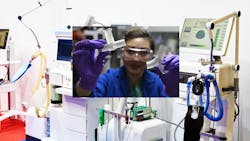Ventilators are the key support in managing acute respiratory distress syndrome (ARDS), a serious lung condition and the leading cause of death for COVID-19 patients. Given the urgent need for more ventilators to treat critically ill COVID-19 patients, the medical profession is scrambling for solutions, including innovating ways in which ventilators can be shared.
READ MORE: Out of Breath: Ventilator Shortage Calls for Agile Innovation
But the practice of sharing ventilators has garnered mixed reviews across the healthcare system. Medical professionals who speak out against sharing ventilators argue that ventilator splitting fosters the spread of germs and would not give the patient the level of oxygen needed, thereby leading to poor outcomes and high mortality rates.
Proponents of ventilator splitting maintain that it is feasible, but acknowledge it must be safe for all patients. “That means ensuring that each patient gets the care they need, without shortchanging anyone,” said Sung Hoon Kang, an assistant professor of mechanical engineering at Johns Hopkins Whiting School of Engineering.
Kang’s team, including ICU intensivists and pulmonary specialists at the Johns Hopkins School of Medicine, are developing and prototyping a 3D-printed splitter that will allow a single ventilator to treat multiple patients.
This new design includes an air-flow controller and flow meters, allowing clinicians to monitor and adjust air flow for each patient. The air volume controller is a key addition because each intubated patient requires different flow control, noted the Johns Hopkins researchers. The team is also adding a filter designed to prevent cross-contamination between patients. This is important, they noted, because early reports suggest that those exposed to multiple infected people experience worse outcomes.
The researchers said their design can be produced with a relatively simple manufacturing process such as 3D printing. The team is also considering scalability of the device by taking into account different conditions and settings where people may be printing the ventilator splitters.
The technique of splitting ventilators has been explored before. For example, ventilator splitting was used in the aftermath of the 2017 Las Vegas shootings to stabilize injured but otherwise healthy young adults. Much more recently, a South Carolina company, Prisma Health, received emergency approval on March 25 from the U.S. Food and Drug Administration for a its 3D-printed ventilator expansion device that splits a ventilator among as many as four patients.
Using the same ventilator settings for ARDS patients with different lung compliances could be very unsafe, according to Julie Caffrey, assistant professor of plastic and reconstructive surgery at Johns Hopkins Medicine and a member of the team. “One patient might receive too much air; the other might not receive enough. With ARDS, ventilator strategies for improving survival are often to administer low tidal volume and higher pressure,” explained Caffrey. “If you can’t manage that, you risk causing further trauma to lungs that are already very crippled. It’s very important that when we split a ventilator, we can still set the ventilator to that specific patient.”
Kang’s research team hopes to finalize and start testing its prototype on model lungs within weeks. Once approved by the FDA, the researchers plan to publish their open-source design for others to use.
About the Author

Rehana Begg
Editor-in-Chief, Machine Design
As Machine Design’s content lead, Rehana Begg is tasked with elevating the voice of the design and multi-disciplinary engineer in the face of digital transformation and engineering innovation. Begg has more than 24 years of editorial experience and has spent the past decade in the trenches of industrial manufacturing, focusing on new technologies, manufacturing innovation and business. Her B2B career has taken her from corporate boardrooms to plant floors and underground mining stopes, covering everything from automation & IIoT, robotics, mechanical design and additive manufacturing to plant operations, maintenance, reliability and continuous improvement. Begg holds an MBA, a Master of Journalism degree, and a BA (Hons.) in Political Science. She is committed to lifelong learning and feeds her passion for innovation in publishing, transparent science and clear communication by attending relevant conferences and seminars/workshops.
Follow Rehana Begg via the following social media handles:
X: @rehanabegg
LinkedIn: @rehanabegg and @MachineDesign

